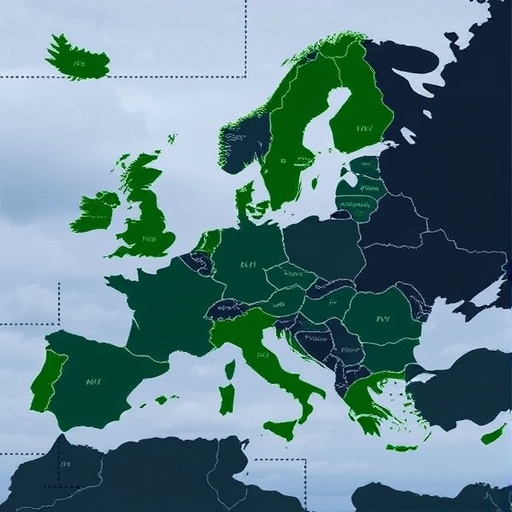In the quest to mitigate climate change, carbon trading systems have emerged as pivotal instruments for regulating greenhouse gas emissions. Among these, the European Emissions Trading System (EU ETS) stands as one of the largest and most influential market-based approaches worldwide. Recently, groundbreaking research by Flori and Spelta has unveiled intricate details about the underlying structures and systemic biases within the EU ETS network, casting new light on how carbon trade operates at mesoscale levels. Their findings not only deepen our understanding of market dynamics but also raise pressing questions about efficiency, equity, and future policy design.
Carbon trading schemes function on the premise of assigning a monetary value to emission allowances, incentivizing companies to reduce their carbon footprints while allowing the buying and selling of surplus credits. Despite the apparent simplicity behind cap-and-trade models, real-world networks that facilitate these trades are far from straightforward. The study by Flori and Spelta dissects the EU ETS, revealing how inherent biases in trade relationships create complex mesoscale structures—a level of organization between micro-level individual transactions and the macroscopic market as a whole.
The researchers employed advanced network theory concepts and data analytics to map thousands of carbon trade transactions between various stakeholders across Europe. Their approach significantly departs from traditional analyses that often treat the market as a homogenous entity. Instead, Flori and Spelta’s analysis identifies clusters and communities of traders linked by preferential trading patterns, reflecting non-random connectivity that carries profound implications for market robustness and information flow.
One of the striking revelations from their work is the presence of “trade biases.” These biases refer to tendencies where certain participants disproportionately trade among themselves, creating network asymmetries. Such phenomena can arise from geographic proximity, sectoral similarities, or institutional affiliations, but they also point to potential structural inefficiencies. For instance, when trades become concentrated within tightly-knit clusters, price signals may fail to propagate effectively throughout the market, potentially undermining the cost-effectiveness of emissions reduction.
Beyond inefficiencies, biased trading patterns can inadvertently lead to power imbalances. In the EU ETS network, Flori and Spelta found that influential actors—often large industrial firms or financial intermediaries—occupy central positions within the mesoscale network, wielding considerable influence over prices and liquidity. This centralization prompts concerns regarding market manipulation risks, as well as the overall fairness of the emissions trading system, which ideally should facilitate equitable access and transparent price discovery.
The study further explores how these mesoscale structures evolve over time, particularly in response to policy shifts and economic shocks. The authors observed that, following regulatory adjustments or external disruptions, the network’s architecture exhibited dynamic rewiring, with clusters growing, merging, or dissolving. This plasticity underscores the adaptive nature of the carbon market but also raises the question of whether such instability might hinder long-term planning and investment in low-carbon technologies.
Technically, Flori and Spelta leveraged sophisticated algorithms that detect community structures within complex networks, combined with econometric modeling to correlate trading patterns with market outcomes. Their methodology highlights the synergy between network science and environmental economics, illustrating the potential of interdisciplinary approaches to decode market mechanisms that traditional analyses might overlook.
Moreover, the research has practical implications for regulators and policymakers. Recognizing the existence and impact of trade biases suggests that interventions could be designed to foster more diverse and balanced trading relationships. Such measures could include enhancing market transparency, encouraging participation from underrepresented players, or implementing anti-concentration rules to prevent dominance by a few entities. By doing so, the system’s efficiency and legitimacy could be significantly improved.
Another critical insight relates to data availability and quality. The authors underscore that accessible, granular transaction-level data is vital for monitoring network dynamics and detecting undesirable patterns promptly. Enhancing data infrastructures within emissions trading schemes should be a priority to enable continuous oversight and adaptive governance strategies that maintain market integrity.
Flori and Spelta’s findings inspire new avenues for further research as well. Extending their network analysis framework to other carbon markets, such as those in North America or Asia, could reveal whether similar mesoscale structures exist globally or are unique to the European context. Such comparative studies would inform the design of international carbon trading frameworks and help harmonize efforts toward global emissions reduction.
Furthermore, understanding how technological innovations, like blockchain or digital platforms, might impact these mesoscale network structures presents an exciting frontier. These technologies could potentially mitigate some trade biases by democratizing access and increasing transparency, yet they might also introduce new complexities or unintended consequences that require careful examination.
At the intersection of climate policy, economics, and network science, this research underscores the value of dissecting market mechanisms at nuanced levels. As the world strives to meet ambitious climate targets, insights into the structural complexities of carbon markets are indispensable for crafting effective and just solutions. The EU ETS, while a pioneering system, still harbors challenges beneath its surface that must be acknowledged and addressed.
In conclusion, the study by Flori and Spelta provides a vital contribution to our understanding of the European Emissions Trading System, exposing hidden network biases and their far-reaching impacts. By shining a light on the emerging mesoscale structures within carbon trading networks, they open the door for more targeted, data-driven interventions that can enhance market function, bolster environmental outcomes, and strengthen global climate governance frameworks in the years to come.
Subject of Research: Carbon trade biases and network structure within the European Emissions Trading System
Article Title: Carbon trade biases and the emerging mesoscale structure of the European Emissions Trading System network
Article References:
Flori, A., Spelta, A. Carbon trade biases and the emerging mesoscale structure of the European Emissions Trading System network. Nat Commun 16, 5199 (2025). https://doi.org/10.1038/s41467-025-59913-w
Image Credits: AI Generated




